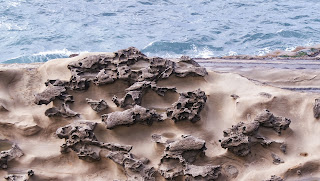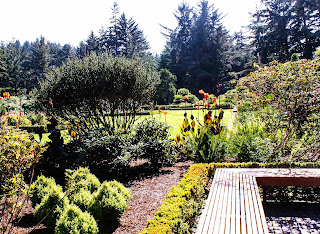One of the first trips we took, when we started RVing in 2007, was to Cape Arago, named for Dominique F. J. Arago, a French physicist and geographer. A theory has been posed that Sir Francis Drake anchored briefly off this cape in the sixteenth century while searching for the rumored Northwest Passage. It was donated to the State of Oregon by the lumber baron Louis Simpson in 1932. It is south of the small town of Charleston, Oregon.
Sculpted by a combination of geological, biological, chemical, and physical forces, the rock formations here seem to blend large, upthrust layers like those at the top of the page with more delicate features, like these, in a perfect mélange of shapes.
This area was, at one time, a large, sandy beach. It now consists of several layers of harder and softer stone that is differentially eroded to create interesting patterns.
This tidepool is constantly refreshed by waves crashing over the top of the rock upon which it sits.
This photo gives a bit of perspective. Those tiny figures are Penny, Mike, and Karen.
Here, it's easy to see evidence of the action of the North American plate riding over the Pacific plate. Several small faults run through this area. You're looking at one on the other side of the large, tilted rock.
These rocks provide great resting places for the many seals and sea lions; like this group, consisting mostly of Stellar seals. We put this in because we knew our friend David would enjoy it.
A small group of harbor seals rests on the second rock from the bottom of this photo. While seals and sea lions are interesting animals, they are quite overpopulated. They take a horrible toll on local fish stock, most notably, anadromous fish like Salmon. We've seen California Sea Lions, arguably the most aggressive of the North American pinnipeds, kill and NOT eat numerous salmon in the Columbia River, seemingly for the fun of it.
Off the coast, clouds, small rain squalls, and the afternoon sun make for an interesting light show.
A Pacific Brown pelican skims below the cliffs. The red areas beneath the bill indicate the transition from non-breeding to breeding adult.
This is Shore Acres Garden, on a part of the former Simpson estate. It is now tended mostly by volunteers. While many of the flowers are past their seasonal prime, it is still beautiful.
There are many delights here. Two bronze cranes watch over this tranquil pond.
Perhaps, one of the last roses of summer, but still lovely and fragrant.













No comments:
Post a Comment